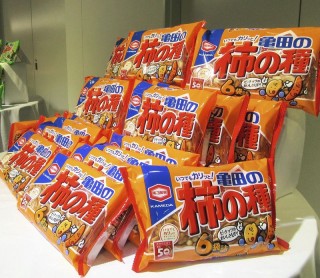Loading
Search
▼ Kaki-no-Tane at 50: More Flavors, Sales
- Category:Gourmet
The Yomiuri Shimbun
This year marks the 50th anniversary of the debut of Kameda Seika Co.’s Kaki-no-Tane snack, made of spicy rice crackers mixed with peanuts.The Niigata-based manufacturer has succeeded in increasing annual sales of its flagship product to ¥20 billion by marketing one variation after another to keep up with the times — but without changing the basic shape and taste.
The secrets to Kaki-no-Tane’s sales longevity include being a spicy snack to fit with the times and also the efforts made to keep consumers interested in the product.
On Jan. 26, Kameda Seika President Isamu Sato revealed a new type of Kaki-no-Tane with the scent of the peanuts made more savory.
Kaki-no-Tane are usually consumed with alcohol drinks, but Sato indicated that the company is aiming to expand the number of consumers of the product, the majority of whom are senior people, to include younger generations.
Kaki-no-Tane was created in Niigata Prefecture in the 1920s after — it is said —someone stepped on and deformed a metallic mold for an oval rice cracker. The name Kaki-no-Tane, which means persimmon seed, was chosen because that is what the resulting shape looked like.
In 1966, Kameda Seika mixed peanuts with Kaki-no-Tane. In the late 1980s, sales were given a tailwind as “dry” beer such as Asahi Breweries’ Super Dry became popular. Kaki-no-Tane became established as a snack to be consumed with alcohol, and the company succeeded in tripling sales within a five-year span from 1988.
Efforts to make the snack a long-term seller have included repeatedly marketing variations, such as wasabi and plum flavors, and also featuring a unique character on the packaging.
Kameda Seika has also succeeded in making young people love its heavily seasoned Happy Turn European-style rice crackers. They have become another long-time seller and flagship snack of the company, and are marking their 40th anniversary this year.
Ryozo Minagawa of Nomura Securities said Kameda Seika has been able to create such long-time sellers because there used to be very few companies in its industry that could mass-produce rice crackers.
Challenges that lie ahead for the company are said to be the development of new flagship products to follow Kaki-no-Tane and also to exploit overseas markets where interest in rice crackers is increasing.
“We will protect what should be protected and change what needs to be changed,” said Sato. What management course Kameda Seika will take is likely to attract a lot of attention in the industry.
This year marks the 50th anniversary of the debut of Kameda Seika Co.’s Kaki-no-Tane snack, made of spicy rice crackers mixed with peanuts.The Niigata-based manufacturer has succeeded in increasing annual sales of its flagship product to ¥20 billion by marketing one variation after another to keep up with the times — but without changing the basic shape and taste.
The secrets to Kaki-no-Tane’s sales longevity include being a spicy snack to fit with the times and also the efforts made to keep consumers interested in the product.
On Jan. 26, Kameda Seika President Isamu Sato revealed a new type of Kaki-no-Tane with the scent of the peanuts made more savory.
Kaki-no-Tane are usually consumed with alcohol drinks, but Sato indicated that the company is aiming to expand the number of consumers of the product, the majority of whom are senior people, to include younger generations.
Kaki-no-Tane was created in Niigata Prefecture in the 1920s after — it is said —someone stepped on and deformed a metallic mold for an oval rice cracker. The name Kaki-no-Tane, which means persimmon seed, was chosen because that is what the resulting shape looked like.
In 1966, Kameda Seika mixed peanuts with Kaki-no-Tane. In the late 1980s, sales were given a tailwind as “dry” beer such as Asahi Breweries’ Super Dry became popular. Kaki-no-Tane became established as a snack to be consumed with alcohol, and the company succeeded in tripling sales within a five-year span from 1988.
Efforts to make the snack a long-term seller have included repeatedly marketing variations, such as wasabi and plum flavors, and also featuring a unique character on the packaging.
Kameda Seika has also succeeded in making young people love its heavily seasoned Happy Turn European-style rice crackers. They have become another long-time seller and flagship snack of the company, and are marking their 40th anniversary this year.
Ryozo Minagawa of Nomura Securities said Kameda Seika has been able to create such long-time sellers because there used to be very few companies in its industry that could mass-produce rice crackers.
Challenges that lie ahead for the company are said to be the development of new flagship products to follow Kaki-no-Tane and also to exploit overseas markets where interest in rice crackers is increasing.
“We will protect what should be protected and change what needs to be changed,” said Sato. What management course Kameda Seika will take is likely to attract a lot of attention in the industry.
- February 11, 2016
- Comment (0)
- Trackback(0)


